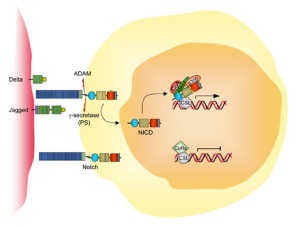Cell signaling is a very important process within multi-cellular organisms. Yet, many people grossly misunderstand how cells could communicate with one another. During the Answers in Genesis conference that stopped by Morris last year, one individual was under the impression that “cellular e-mail” must exist. “Why? Well, because it must!” *sigh* So, the pathway that I’m going to look at is Notch. Why? Well, because I must! It’s also pretty cool, I swear.
So here we have the Notch pathway.  Notch is a transmembrane protein which means it goes straight through the cell membrane and protrudes on either side. This protein acts as a form of hair-trigger. When activated it cleaves the inside part which heads off to the nucleus to play with gene expression. Notch isn’t activated by just any protein flying into it, and this is where Delta comes into play. Now the specifics vary depending on species (humans don’t actually have Delta but it’s similar and therefore Delta-like) but the purpose remains relatively the same.
Notch is a transmembrane protein which means it goes straight through the cell membrane and protrudes on either side. This protein acts as a form of hair-trigger. When activated it cleaves the inside part which heads off to the nucleus to play with gene expression. Notch isn’t activated by just any protein flying into it, and this is where Delta comes into play. Now the specifics vary depending on species (humans don’t actually have Delta but it’s similar and therefore Delta-like) but the purpose remains relatively the same.
**Now, I’m grossly oversimplifying the Notch pathway. I do this not because the areas I’m overlooking are not important (they are!), but this is a neurology post and it’s far too easy to get bogged down in minutia of everything and overlook the cool stuff of one area. **
So Delta and Notch touch, part of Notch breaks off and heads off into the cell to make shenanigans. What does this shenaniganary have to do with cell signaling and the nervous system? These have two functions. One is to adhere the two cells to one another. The other function is in development, in this case neuro-development. Once the cell with Delta contacts the Notch cell the piece inside breaks off and heads for the nucleus. What it does here is stop the cell from differentiating while the Delta cell remains able to do so. Notch inhibits rather than induces. It’s a bit backwards from what you would expect, but the role of Notch in neural development is to say who cannot become neural tissue. As for the Delta cell, eventually it will move out of the epithelial layer and differentiate into a neuroblast.
If you think about it, this makes sense. If something induces neural differentiation then something should also stop it to avoid something made entirely of nervous system. Now, I can’t emphasize enough that Notch does other things. Those things just reach beyond the scope of this class. This is just a quick look at how two little things poking out of a cell can have a big impact.
September 7th, 2011 at 10:47 am
An important aspect of the lateral inhibition model you propose is that the lateral inhibition is reinforced with feedback. One of the things that Notch signaling can do is to down-regulate Notch ligands in the signal receiving cell. Thus, the more signal a cell receives, the less signal it can send back to its neighbor. This helps reinforce the two distinct cell fates. A number of people have written simple simulator programs for this kind of process, where you can play around with the parameters of the system and generate different kinds of stable pattern.
Notch can also act in a positively inductive fashion, for example in the Drosophila eye and wing imaginal discs.
September 7th, 2011 at 11:28 am
I thought this was a great post. The simplicity of it is able to help even the unknowledgable to quasi understand.
September 7th, 2011 at 3:39 pm
Great post. I did some work last year on the relationship between the Notch and VEGF pathways in vascular development. Its definitely a pretty complicated mess of signalling and you did a good job of summing it up in a short post.
September 7th, 2011 at 6:20 pm
Nice!
One thing I’ve learned is that there are two types of neurobiologists: those who study Delta/Notch, and those who don’t know that they study Delta/Notch.